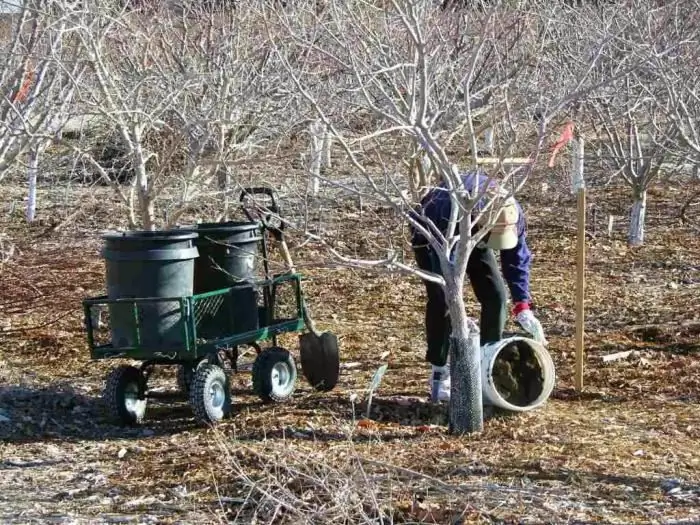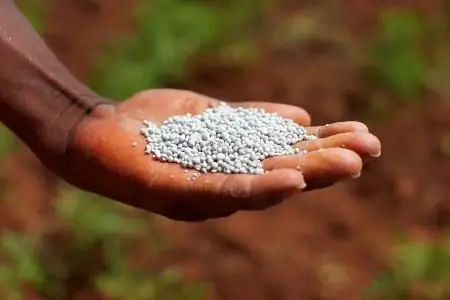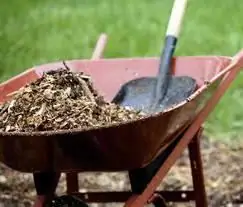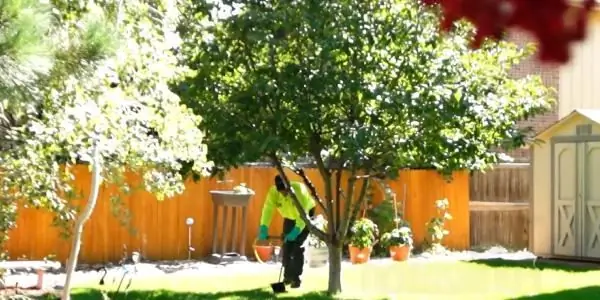One of the most important components of garden care is the spring feeding of fruit trees and shrubs in the spring. Without this, it is impossible to achieve an attractive appearance of ornamental plants, as well as an abundant harvest of fruit crops. Remember that proper feeding of shrubs and trees in spring is not only able to saturate the plant with additional elements, but also maintain soil fertility, improve its chemical and mechanical properties.
Feed composition
During the growing season, a tree repeatedly changes its need for nutrients. It is in early spring, at the beginning of the growing season, that plants need to be saturated with potassium, a little less - with nitrogen and phosphorus. During the flowering period and during its end, the tree needs nitrogen. At this time, there is an intensive growth of shoots. After that, the plants need phosphorus.

Spring feeding of fruit trees and shrubs is necessary. But before proceeding with this procedure, you should consider allfeatures of each type of tree. For example, conifers require significantly less nitrogen than apple and other deciduous trees. After all, conifers do not need to grow fallen leaves again. It is also known that in fruit trees, with high yields and over time, nutrients are washed out of the soil.
The amount of nutrients that are contained in the soil (phosphorus, nitrogen, etc.) directly depends on the concentration of humus that is in it. In sandy soil, its content is minimal, compared with loam or clay. The content of potassium is directly related to the mechanical composition of the soil. Its content in the sand is also minimal.
During spring feeding, all this must be taken into account.
Feeding in March
Spring feeding of fruit trees and shrubs in spring should begin in March. Fertilizers must be applied directly to the snow that melts. It is very comfortable. After all, it will become easier to walk on the snow, and with the time of melting, it will pull fertilizer into the soil with it.

Soluble pre-mineral mixtures must be scattered into the near-stem circle with a handful (approximately 30-40 grams). For young trees, only one or two handfuls can be used. Mature trees require more fertilizer (two to five).
Feeding young fruit trees and shrubs in spring should be evenly distributed around the trunk circle. The diameter should be more than 1.5 m. For older trees, it is necessary to scatterfertilizer around the perimeter of the entire crown. In this zone, the largest number of roots are located, which actively carry out absorption. But if the trees are located on a sloping site, such fertilization should not be carried out. They will quickly be washed away by meltwater, which often does not linger on the slopes. The same can happen in the case of heavily frozen ground and a lot of snow.
Feeding in April
Remember that only nitrogen fertilizers can be applied with snow. In April, when the snow finally melts, phosphorus and potassium must be added to the soil. For this, superphosphate, ash and potassium sulfate are used. When choosing fertilizers, pay attention to the composition. Indeed, for example, complex mixtures should not be used in April, because they consist of a large amount of nitrogen. In this case, you can significantly exceed the content of this element in the soil. This, in turn, can lead to a decrease in plant viability and provoke the development of various fungal diseases.
The two most commonly used feeding options are:
- nitrogen fertilizers are used in March, and phosphorus and potash fertilizers are used in April;
- use complex spring fertilizers in both March and April.
Feeding in May
In May, you should also take care of the plants. Spring feeding of fruit trees and shrubs in spring, in May, involves the use of rotted manure or mature compost. If you don't have organics on hand, you can use a complex mineral mixture in which the nitrogen content is slightly exceeded. Dose in MayFertilization also depends on the soil and its fertility. The maximum dose should be used for wood-podzolic soil types, the minimum for chernozem, and the average for forest sulfur.

Feeding fruit trees and shrubs in the spring is quite effective when using fertilizer-soaked mulch, which covers the tree trunks. It becomes an effective top dressing, especially if straw, compost or rotten leaves are poured into it.
Fertilizer for trees
Spring feeding of fruit trees and shrubs in early spring together with organic and mineral fertilizers is ideal for fruit and deciduous crops. But this scheme is completely unacceptable for evergreens. Such complex fertilizers will have an undesirable effect on them.
After all, these mixtures contain quite large amounts of nitrogen, which causes the active growth of new shoots. And not every tree can withstand such an action. Manure is also not used for these types of trees.
For coniferous plants, it is best to use special fertilizers that are designed specifically for feeding coniferous species. They have a completely different composition of the main trace elements. Such fertilizers contain a large number of substances, among which magnesium must be present. From organic matter, it is better to use biohumus and rotted compost.

Rememberthat the use of spring fertilizers is necessary only for old conifers. For such breeds, remember: it is better to let the tree go without feeding than to overfeed it.
What you need to know?
Spring feeding of fruit trees and bushes has some rules that every gardener should remember!
1. The root system of the tree will most quickly absorb liquid fertilizer.
2. Feeding seedlings is necessary only after full rooting.
3. Each top dressing should be carried out in cloudy weather or late in the evening.
4. Dry fertilizers should be applied either before watering or immediately after it. An exception is the March top dressing, which is applied over melting snow.

Remember that liquid fertilizer should only be applied to moist soil. If you do not follow this rule, then the root system of the tree may get burned. They, in turn, can lead to a long illness of the plant or even to its death.
Shrub fertilizer
Spring top dressing of fruit trees and shrubs in spring will allow you to get a good harvest. The first feeding should be carried out during the formation of new shoots (up to approximately 2 cm).
If potash, phosphorus, and organic fertilizers were applied in the fall, then only nitrogen fertilizers should be used in the spring. In the root zone you need to add:
- Ammonium nitrate - 20g;
- Calcium nitrate - 35-40 g;
- Ureas - 12-15 g.
Feeding fruit trees and shrubs in the spring with organic matter should be carried out if fertilizers have already been applied in the autumn. To do this, dilute manure with water in a bucket and add 1 table there. a spoonful of urea. Under each plant, it is necessary to introduce such a bucket of top dressing of 2-3 liters. Remember that immediately after such top dressing, it is necessary to carry out abundant watering of the plant. The second top dressing in the same way should be carried out in two weeks. We also carry out the third feeding.

If you don't have access to organic fertilizers, you can replace them with mineral fertilizers. Such a fertilizer must be prepared independently from a bucket of water, 25 g of superphosphate, 20 g of ammonium nitrate and 15 g of potassium sulfate. Such a bucket is designed for 2-3 bushes. After fertilizing, it is necessary to water the plant abundantly.
Remember that the holes under the bushes should be no more than 60 cm in diameter and 10 cm deep. After fertilization and abundant watering, the holes must be covered with earth or mulched with peat.






